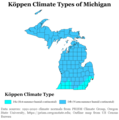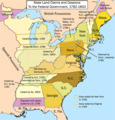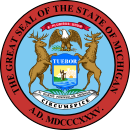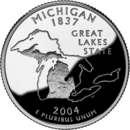Portal:Michigan
The Michigan Portal  Michigan (/ˈmɪʃɪɡən/ MISH-ig-ən) is a state in the Great Lakes region of the Upper Midwest region of the United States. It borders Wisconsin to the northwest in the Upper Peninsula, and Indiana and Ohio to the south in the Lower Peninsula; it is also connected by Lakes Superior, Michigan, Huron, and Erie to Minnesota and Illinois, and the Canadian province of Ontario. With a population of nearly 10.12 million and an area of 96,716 sq mi (250,490 km2), Michigan is the 10th-largest state by population, the 11th-largest by area, and the largest by area east of the Mississippi River. Its capital is Lansing, and its largest city is Detroit. Metro Detroit is among the nation's most populous and largest metropolitan economies. The name derives from a gallicized variant of the original Ojibwe word ᒥᓯᑲᒥ (mishigami), meaning "large water" or "large lake". Michigan consists of two peninsulas. The Lower Peninsula resembles the shape of a mitten, and comprises a majority of the state's land area. The Upper Peninsula (often called "the U.P.") is separated from the Lower Peninsula by the Straits of Mackinac, a five-mile (8 km) channel that joins Lake Huron to Lake Michigan. The Mackinac Bridge connects the peninsulas. Michigan has the longest freshwater coastline of any political subdivision in the United States, being bordered by four of the five Great Lakes and Lake St. Clair. It also has 64,980 inland lakes and ponds. Michigan has the second-most water area of any state, behind only Alaska. The area was first occupied by a succession of Native American tribes over thousands of years. In the 17th century, French explorers claimed it as part of the New France colony, when it was largely inhabited by Indigenous peoples. French and Canadian traders and settlers, Métis, and others migrated to the area, settling largely along the waterways. After France's defeat in the French and Indian War in 1762, the region came under British rule. Britain ceded the territory to the newly independent United States after its defeat in the American Revolutionary War. The area was part of the larger Northwest Territory until 1800, when western Michigan became part of the Indiana Territory. Michigan Territory was formed in 1805, but some of the northern border with Canada was not agreed upon until after the War of 1812. Michigan was admitted into the Union in 1837 as the 26th state, a free one. It soon became an important center of industry and trade in the Great Lakes region, attracting immigrants in the late 19th and early 20th centuries from many European countries. Immigrants from Finland, Macedonia, and the Netherlands were especially numerous. Migration from Appalachia and of Black Southerners as part of the Great Migration increased in the 1930s, with many settling in Metro Detroit. Although Michigan has developed a diverse economy, in the early 20th century it became widely known as the center of the U.S. automotive industry, which developed as a major national economic force. It is home to the country's three major automobile companies (whose headquarters are all in Metro Detroit). Once exploited for logging and mining, today the sparsely populated Upper Peninsula is important for tourism because of its abundance of natural resources. The Lower Peninsula is a center of manufacturing, forestry, agriculture, services, and high-tech industry. (Full article...) Entries here consist of Good and Featured articles, which meet a core set of high editorial standards.
The 2010 Carfax 400 was a NASCAR Sprint Cup Series stock car race that was held on August 15, 2010 at Michigan International Speedway in Brooklyn, Michigan. Contested over 200 laps, it was the twenty-third race of the 2010 Sprint Cup Series season. The race was won by Kevin Harvick for the Richard Childress Racing team. Denny Hamlin finished second, and Carl Edwards, who started twenty-fourth, clinched third. Pole position driver Kasey Kahne maintained his lead into the first corner to begin the race, but Jimmie Johnson, who started in the second position on the grid, took the lead before the first lap was over. Afterward, Greg Biffle became the leader, and would eventually lead to the race high of 66 laps. Tony Stewart led after the final pit stops, ahead of Hamlin and Harvick. Harvick helped Hamlin to become the leader, but with twelve laps left, Harvick gained on Hamlin and claimed the first position with eleven laps remaining. Harvick maintained his position to claim his first Sprint Cup victory at Michigan International Speedway. (Full article...)Selected picture -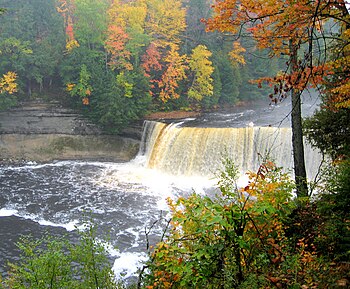 The Tahquamenon Falls are two different waterfalls on the Tahquamenon River. Both sets are located near Lake Superior in the eastern Upper Peninsula of Michigan. The water is notably brown in color from the tannins leached from the cedar swamps which the river drains. Did you know -
Related portalsSelected article -James Riddle Hoffa (born February 14, 1913 – disappeared July 30, 1975, declared dead July 30, 1982) was an American labor union leader who served as the president of the International Brotherhood of Teamsters (IBT) from 1957 until 1971. From an early age, Hoffa was a union activist, and he became an important regional figure with the IBT by his mid-20s. By 1952, he was the national vice-president of the IBT and between 1957 and 1971 he was its general president. He secured the first national agreement for teamsters' rates in 1964 with the National Master Freight Agreement. He played a major role in the growth and the development of the union, which eventually became the largest by membership in the United States, with over 2.3 million members at its peak, during his terms as its leader. (Full article...)Selected biography -Paul Gordon Goebel (May 28, 1901 – January 26, 1988) was an American football end who played for the University of Michigan Wolverines from 1920 to 1922. He was an All-American in 1921 and was the team's captain in 1922. He played professional football from 1923 to 1926 with the Columbus Tigers, Chicago Bears, and New York Yankees. He was named to the NFL All-Pro team in 1923 and 1924. After his football career ended, he operated a sporting good store in Grand Rapids. He officiated football games for the Big Ten Conference for 16 years and also served in the U.S. Navy on an aircraft carrier in World War II. He was active in Republican Party politics in Grand Rapids, Michigan, and was one of the organizers of a reform movement to oust the city's political boss, Frank McKay. As an anti-McKay reform candidate, Goebel was three times elected mayor of Grand Rapids in the 1950s. He was later elected to the University of Michigan Board of Regents, where he served from 1962 to 1970. (Full article...)General imagesThe following are images from various Michigan-related articles on Wikipedia.
TopicsCategoriesSymbols
Lists
Related pagesWikimediaThe following Wikimedia Foundation sister projects provide more on this subject:
Things you can doDiscover Wikipedia using portals | ||||||||||||||||||||||||||||||||||||



























